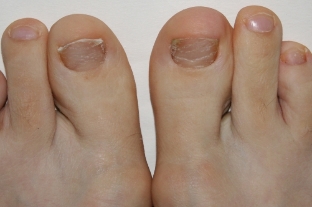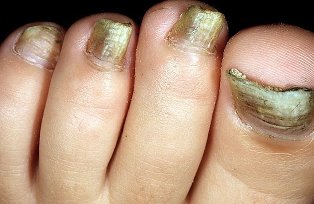Many are not even aware that banal sweating and legs, accompanied by unpleasant smell than the suffering of more than half of the population of our planet is one of the main symptoms of nail fungus. This disease runs the risk of Developing any player who neglects personal hygiene. Nail fungus is lurking everywhere, especially in public areas. And the worst thing is that nail fungus — a rather insidious disease: its treatment is long and not always successful, such as athlete's foot is prone to relapse. In order to identify the disease and start treatment, you should know all the signs of fungus on the feet.

The spread of the disease?
The infection causes parasitic fungi. The ideal environment for their reproduction and development — high humidity combined with warm atmosphere. It is considered that the most important place, which is a high risk of Developing nail fungus, it is a spas, saunas, water parks, swimming pools, nail salons, etc. statistics, However, completely denied these allegations: nail fungus you can pick up at home using some common services (towels, shoes, clothes, carpet, shower or bathtub), if one of your family members already have this problem, or at a party, for example, through the Shoes, kindly offered by the host (and he can even suspect, that it would be a disease).
But what factors affect the development of fungal diseases? To celebrate these important moments, which lead to the infection in onychomycosis:
- the lowered immunity;
- damage to the nail plate;
- poor circulation in the lower extremities, which can occur when wearing tight shoes;
- foot anatomical pathology nature;
- obesity;
- diabetes mellitus;
- excessive sweating.
At least partially protect yourself, you should use only their things, carefully treated with antiseptics, bath and shower, use of personal towels, regularly clean and wash the carpet, disinfect shoes. And not to lose the favorable treatment of mycosis of the moment (after all, everyone knows that the most effective treatment is early stages of the disease), you need to know the first signs of nail fungus on the feet.
How to recognize onychomycosis?
Symptoms of nail fungus at different stages may differ from each other, indicating that the progression of infection. For example, the first (early) stage no symptoms are practically absent. The nail plate, you can see, hardly visible whitish spots or streaks. These symptoms should not cause concern, because they can talk about the presence of a fungal infection. If you ignore the first symptoms, there is a risk to start a fungus that affects healthy nails and leads to the appearance of pus in the tissues of the periungual and this can lead to gangrene and amputation of the lower limbs.
Secondary fungal nail disease occurs in the lack of natural Shine of the nail plate. In addition, the nail changes color, appearing yellow, white and brown stripes. Can change the shape to the top of the nail and side panels. These symptoms are clearly visible in the photo.
Far onychomycosis is characterized by brittleness and delamination of the nail plate, inflammation of the cuticle. There is the risk of loss of the nail. But the unpleasant fact, that the disease is still spread to other nails of the lower extremities, and the skin of the foot. Treatment in this case should start immediately in order to avoid the unpleasant consequences of the disease.

The second and third stage patients, that the patient can identify yourself: the nail takes on a yellow or dirty brown color, it becomes loose and thick in the back of the nail bed, it becomes very brittle and fragile. Sometimes wearing a closed Shoe becomes painful and itchy skin — unbearable (this symptom is especially improved at high sweating). In addition, the reason is suspected onychomycosis to the following accompanying symptoms appear on the skin close to the nails:
- burning;
- intolerable itching;
- flaking and dryness;
- inflammation;
- weeping lesions;
- thickening and keratinization.
To identify the first signs of nail fungus, you should immediately contact a specialist who will prescribe the best treatment.
What impact is different for onychomycosis?
Define the 3 types of onychomycosis, each of which embodies its own characteristics.
- Normotroficheskie nail fungus is characterized by a change in color of the nail plate: a sick nail can take shades from white to dark green. In the first stage of the disease, the nail may appear white round spots and longitudinal direction. As the disease progresses the tone of the nail can vary, and fungal spread to the whole area of the nail plate. However, its thickness does not change, and the natural Shine is maintained.
- Hypertrophic nail fungus occurs color change of the nail plate, loss of gloss surface, strong thickening and deformity. Nails strongly exfoliate, began their partial destruction.
- Atrophic fungus is characterized by a change in nail color its further thinning. As a result, the fungal infection is the disease, the patient's nail, or the infected area.
To determine the presence of fungus on the nails can be yourself, however, is based on the exact diagnosis can only specialist. For this you need to visit the clinic, take the analysis of the patient scraping of the nail or skin, which are located around it. In addition, a dermatologist appoint microscopic examination.
Signs of the fungal pathogen
Successful treatment of nail fungus depends on how correctly diagnosed the causative agent of the disease. The reason is that the disease causes than one fungal species, but several, and each of them sensitive to certain drugs. That is, if one variety of a fungus resistant to one drug, another pathogen, which means death.

Often nail fungus causes:
- yeast;
- dermatophytes;
- mold.
If the cause of nail fungus yeast begins to recognize the disease at once is almost impossible. Signs of fungus on the nails in this case are the following (they occur after a long period of time): peel, nail plate and light itching of the skin around the nail (the itching can be omitted). Infection nail yeast is found to 4-4,5% of cases.
Dermatophytes affect the nails much more often than in the previous pathogen is 94.5% of all cases of infection of nail fungus. Dermatophytes there are three kinds, infecting each of them is manifested in different ways:
- The first type is characterized by complex lesions of the legs, feet and nails. Fungus spreads easily on the skin and nails on the hands.
- The second type affects only the little finger nail or the big toe. Can spread to the toes of the folds, and all the fingers and some.
- The third type is characterized by the loss of the nails of the thumb and little finger, but the skin of the fungus is not affected.
The latter type of fungal mold. Its pathogen — fungi. This disease is found only in 1% of cases. To develop mushrooms this species more frequently in HIV-infected people.
Other symptoms of fungal infection in the nails
Often at the beginning of the disease the obvious signs of fungus on the nails does not exist. However, if you are observant, you will notice some changes in the structure of the nail and its look. As mentioned earlier, the nail plate can occur in the longitudinal or round whitish spots, the nail may be oblique, though its smoothness and Shine disappear. Progressing, the disease increasingly destroys the nail plate: first change its shade, then the nail surface is scaly, it thickens or becomes thin, peeling, breaking. The color of the nail depends on the fungus became a pathogen.
In addition to the basic features of onychomycosis, there are other

- the fragility of the edges of the nail plate or the entire surface;
- distort the shape of the nail, changing its structure;
- the blackening of the nail.
- cut the nails under the skin;
- dysbiosis, drowsiness, weakness;
- detachment of the plate from the nail bed, which leads to the formation of plaque under the nail whitish or yellow color with an unpleasant odor;
- itching, cracking, burning of the skin in the immediate vicinity of the affected nail;
- dysbiosis, drowsiness, General weakness.
Any deviation from the appearance of the toenails should be alerted, as this may indicate the development of nail fungus. The first measure in this case — a trip to the dermatologist, who will confirm or deny your fears. If this is not done immediately, the disease will progress. At first glance, nothing in this disease is not. However, in addition to purely aesthetic problems and discomfort, the fungus can cause serious complications, even a purulent infection of the affected areas and even the development of gangrene. Therefore, do not tighten the treatment, to take action immediately, because the disease was detected.





























